
Science & Technology
of Beowulf

Angon
- Javelin spear based on Roman pilum
- Once it struck shield, barbs locked it in place
- Cheap to make and allowed for distance from target
- Used by peasants all the way to nobility

scramseax
- Carried by all levels of warriors
- Doubled as everyday all-purpose pocket knife
- Hadseax was shorter (3-14 inches)
- Langseax was longer (22-30 inches)

Axe
- Most commonly associated with Scandinavians
- Made using wood and joining it to blade
- Great for offense, instilled fear and could be swung in rage
- Terrible for defense, could be easily disarmed

MIssiles
- Anglo-Saxons used bows mainly for hunting
- Could be used in battle, with mass arrows fired
- Iron arrowheads were usually too big to pierce mail
- Arrowheads eventually became small enough
- Slings were also used


Swords
- Uncommon, handed down thru generations
- The Roman spatha influenced design
- Blade was approximately 30 inches long
- Required master skill to forge a good sword
- Leather scabbard protected from weather


MAIL Armor
- Earliest known use by Etruscans
- Used by northern Italian Gauls
- Adopted by Romans
- Widely used until Middle Ages
- Phased out in favor of plated armor
MAIL Armor
- Adopted as main armor for Anglo-Saxons
- Forged using links of small iron
- Covered arms to protect cavalry
- Effective against swords
- Didn't fare as well against arrows and clubs



Soldiers depicted wearing mail armor
helmets
- Designed to protect head against sword strike
- Made of riveted or single iron sheet
- Typically had mail curtain behind to protect neck
- Domed shape gave way to pointed top


Shields
- Round shields were the norm from 1st to 10th century
- After 10th century, started covering legs and lower body
- Rimmed with leather or hide
- Center was reinforced with metal


The famous shield wall used at Hastings

- Metal has always been linked with power
- Very important commodity for the Anglo-Saxons
- Highly versatile
- Like Bronze 2.0 but better
- Used to make diverse items
- Farm tools and knife were more practical

Smiths were highly regarded

A crucible device used to weld